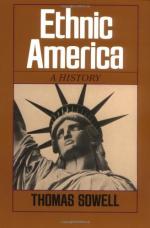
|
| Name: _________________________ | Period: ___________________ |
This test consists of 15 multiple choice questions and 5 short answer questions.
Multiple Choice Questions
1. How many slaves came to the Western Hemisphere?
(a) Five million.
(b) Twenty million.
(c) One million.
(d) Ten million.
2. What mode of travel was first predominantly used in the Puerto Rican migration to the U.S.?
(a) Sailing ships.
(b) Steamships.
(c) Rail.
(d) Air.
3. How were Japanese immigrants treated initially?
(a) They were hated.
(b) They were tolerated.
(c) They were rejected.
(d) They were welcomed.
4. During the Civil War, what percentage of Union troops were black?
(a) 2%.
(b) 10%.
(c) 50%.
(d) 5%.
5. Which religion forbade the owning of slaves and produced many abolitionists?
(a) Catholic.
(b) Presbyterian.
(c) Methodist.
(d) Quaker.
6. What was a "picture bride"?
(a) A bride from Japan accepted on the basis of a photograph.
(b) A perfectly beautiful bride.
(c) A bride who spoke no English.
(d) A bride from the U.S. accepted on the basis of a photograph.
7. What was a Californio?
(a) An enslaved California Hispanic of the 19th century.
(b) A wealthy California Hispanic of the 19th century.
(c) A California stagecoach robber.
(d) A wealthy California Hispanic of the 20th century.
8. What is a "wetback"?
(a) An agricultural worker who perspires freely.
(b) A strong swimmer.
(c) An illegal Mexican immigrant.
(d) A mariachi musician.
9. How did Chinese immigrants cope with discrimination?
(a) Withdrawal and inconspicuousness.
(b) Fear and intimidation.
(c) Aggression and violence.
(d) Pugnacity and toughness.
10. Why have the Chinese been called "the Jews of Asia?"
(a) They have been universally excluded.
(b) Their success in business has been resented.
(c) They have been universally welcomed.
(d) Their success in business has been applauded.
11. What was one tragic result of the U.S. government's restrictions on Chinese immigration?
(a) A low Chinese birth rate.
(b) A low return on Chinese investment.
(c) A high rate of suicide among Chinese men.
(d) A high rate of Chinese returning to China.
12. What percentage of Puerto Ricans voted to be accepted as a U.S. state?
(a) 10%.
(b) 74%.
(c) 60%.
(d) 39%
13. What drug was introduced in the U.S. by Chinese immigrants?
(a) Marijuana.
(b) Cocaine.
(c) Heroin.
(d) Opium.
14. Why did many Japanese property owners in the U.S. put title to the land in the names of their children?
(a) The children were born in the U.S. and not subject to the Alien Land Law.
(b) They hoped for greater prosperity for their children.
(c) The children could avoid excessive taxation.
(d) They children could attract better marriage partners.
15. What did Chinatowns become in the 20th century?
(a) Slums.
(b) Crime-infested areas.
(c) Danger zones.
(d) Tourist attractions.
Short Answer Questions
1. What gave free persons of color a head start over other blacks?
2. What was a Pachuco?
3. How long is the border between the U.S. and Mexico?
4. What was unique among immigrant groups about Chinese population size in the U.S.?
5. What type of immigrant group is most likely to retain a foreign language and culture?
|
This section contains 517 words (approx. 2 pages at 300 words per page) |

|




